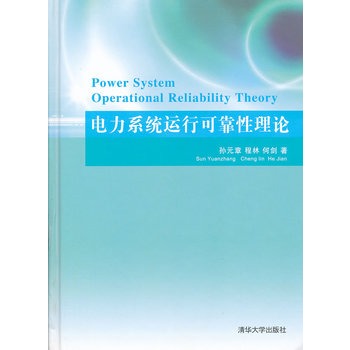《電力系統運行可靠性理論》是2012年清華大學出版社出版的圖書,作者是孫元章、程林、何劍。
基本介紹
- 書名:電力系統運行可靠性理論
- 作者:孫元章、程林、何劍
- ISBN:9787302263388
- 定價:59元
- 出版社:清華大學出版社
- 出版時間:2012年6月
內容簡介,目錄,
內容簡介
本書系統地介紹了電力系統運行可靠性理論研究的最新成果,全書共10章,分別為緒論、運行可靠性的概念與理論框架、運行可靠性理論的數學基礎、電力系統元件的運行可靠性模型、電力系統運行的可靠性指標、系統狀態選擇的快速算法、電力系統運行可靠性評估、電力系統運行可靠性最優控制、電力系統運行可靠性的軟體平台、結論與展望,並附有參考文獻以方便讀者查閱。
本書可供從事電力系統規劃、運行及管理人員在實際工作中參考,也可供電力專業科技人員、高等院校有關專業教師和高年級研究生參考。
目錄
第1章 緒論1
1.1 運行可靠性理論的背景與意義1
1.2 電力系統評估理論的研究進展3
1.2.1 發展趨勢概述3
1.2.2 確定性的靜態安全評估4
1.2.3 常規可靠性評估6
1.2.4 基於風險的靜態安全評估12
1.3 電力系統控制決策研究進展14
1.3.1 基於確定性準則的靜態安全控制15
1.3.2 基於機率風險的決策最佳化15
第2章 運行可靠性的概念與理論框架17
2.1 運行可靠性的概念與特點17
2.1.1 相對於確定性靜態安全評估的特點18
2.1.2 相對於常規可靠性評估的特點18
2.1.3 相對於基於風險的靜態安全評估的特點19
2.2 運行可靠性的理論框架與關鍵問題19
第3章 運行可靠性理論的數學基礎23
3.1 機率與隨機過程23
3.1.1 機率的定義與性質23
3.1.2 隨機變數及其分布25
3.1.3 隨機過程28
3.1.4 馬爾可夫過程31目 錄電力系統運行可靠性理論 3.2 可靠性的數學基礎37
3.2.1 不可修復元件的可靠性38
3.2.2 可修復元件的可靠性45
第4章 電力系統元件的運行可靠性模型51
4.1 保護動作致停運模型52
4.1.1 線路過負荷保護動作模型52
4.1.2 發電機電壓、頻率保護動作模型54
4.1.3 減載裝置動作模型59
4.2 偶然失效模型63
4.2.1 發電機偶然失效模型63
4.2.2 線路、變壓器偶然失效模型67
4.3 老化失效模型69
4.3.1 發電機老化失效模型69
4.3.2 變壓器老化失效模型70
4.3.3 輸電線老化失效模型72
4.4 模型數據需求75
4.4.1 常規可靠性模型數據統計75
4.4.2 運行可靠性模型數據需求75
第5章 電力系統運行可靠性指標78
5.1 常規可靠性的指標體系78
5.2 運行可靠性的指標體系80
5.3 運行可靠性指標的計算公式83
5.3.1 狀態類指標83
5.3.2 程度類指標83
第6章 系統狀態選擇的快速算法89
6.1 快速排序算法89
6.1.1 基本思想89
6.1.2 基於兩狀態元件模型的快速排序技術90
6.1.3 計及多狀態元件模型的快速排序技術97
6.1.4 基於快速排序技術的系統狀態選擇算法103
6.1.5 算例分析104
6.1.6 算法小結106
6.2 狀態空間分割算法107
6.2.1 基本思想107
6.2.2 狀態空間分割算法及流程109
6.2.3 算法收斂性證明113
6.2.4 算例分析115
6.2.5 算法小結123
第7章 電力系統運行可靠性評估125
7.1 運行可靠性短期評估125
7.1.1 元件瞬時狀態機率126
7.1.2 系統狀態機率隨時間變化分析127
7.1.3 短期評估算法128
7.1.4 計及運行備用的短期評估128
7.1.5 算例分析130
7.2 條件相依的運行可靠性評估132
7.2.1 條件相依的運行可靠性評估算法133
7.2.2 算例分析133
7.3 運行可靠性綜合評估139
7.3.1 基於支持向量機的天氣預測技術140
7.3.2 運行可靠性薄弱環節定位143
7.3.3 運行可靠性綜合評估算法145
7.3.4 算例分析146
第8章 電力系統運行可靠性最優控制159
8.1 運行可靠性最優控制的概念與功能定位160
8.2 運行可靠性最優控制的技術基礎161
8.2.1 運行可靠性成本和價值的概念161
8.2.2 運行可靠性成本價值指標162
8.2.3 運行可靠性成本價值評估算法162
8.3 運行可靠性最優控制數學模型164
8.4 ?P-Q?解耦的粒子群最佳化算法165
8.5 算例分析169
8.5.1 六母線測試系統169
8.5.2 IEEE RTS測試系統176
8.5.3 MRTS測試系統178
8.5.4 算例小結179
第9章 電力系統運行可靠性的軟體平台181
9.1 軟體平台設計思路和主要框架181
9.2 模組功能介紹183
9.2.1 數據導入導出模組183
9.2.2 潮流計算模組183
9.2.3 元件可靠性模型模組184
9.2.4 輸出顯示模組184
9.3 可視化技術184
9.3.1 網架結構可視化185
9.3.2 網路潮流可視化185
9.3.3 可靠性指標可視化185
9.3.4 數據報表可視化187
第10章 結論與展望188
附錄A IEEE RTS測試系統數據191
A.1 系統概況191
A.2 負荷模型192
A.3 發電系統194
A.4 輸電系統196
A.5 其他數據201
參考文獻203
Chapter 1 Introduction1
1.1 Background and motivation of power system operational
reliability theory1
1.2 Review on power system evaluation theory3
1.2.1 Overview3
1.2.2 Deterministic steady-state security evaluation4
1.2.3 Traditional probabilistic reliability evaluation6
1.2.4 Risk-based steady-state security evaluation12
1.3 Review on power system control and decision-making14
1.3.1 Steady-state security control based on
deterministic criterion15
1.3.2 Optimal decision-making methods based on
probabilistic criterion15
Chapter 2 Concept and framework of power system
operational reliability17
2.1 Concept and features of power system operational
reliability17
2.1.1 Features compared to deterministic steady-state
security evaluation18
2.1.2 Features compared to traditional reliability
evaluation18
2.1.3 Features compared to risk-based steady-state
security evaluation19 2.2 Framework and key points of power system operational
reliability19
Chapter 3 Mathematical foundations of power system operational
reliability theory23
3.1 Probability and stochastic process23
3.1.1 Definition and properties of probability23
3.1.2 Random variable and its distribution25
3.1.3 Stochastic process28
3.1.4 Markov process31
3.2 Mathematical foundations of reliability37
3.2.1 Reliability of non-repairable component38
3.2.2 Reliability of repairable component45
CONTENTS電力系統運行可靠性理論Chapter 4 Operational reliability models of power system
components51
4.1 Protection outage model52
4.1.1 Overload protection outage model of a transmission line52
4.1.2 Voltage and frequency protection outage model of
a generator54
4.1.3 Load-shedding protection outage model59
4.2 Random failure model63
4.2.1 Random failure model of a generator63
4.2.2 Random failure model of a transmission line/transformer67
4.3 Aging failure model69
4.3.1 Aging failure model of a generator69
4.3.2 Aging failure model of a transformer70
4.3.3 Aging failure model of a transmission line72
4.4 Date requirements75
4.4.1 Statistics in traditional reliability model75
4.4.2 Data requirements in operational reliability model75
Chapter 5 Power system operational reliability indices78
5.1 Index system of traditional reliability78
5.2 Index system of operational reliability80
5.3 Expressions of operational reliability indices83
5.3.1 Indices for system state83
5.3.2 Indices for system severity83
Chapter 6 Fast algorithms for system-state selection89
6.1 Fast sorting technique89
6.1.1 Basic idea89
6.1.2 Fast sorting technique considering two-state components90
6.1.3 Fast sorting technique considering multi-state
components97
6.1.4 System-state selection by using the fast sorting
technique103
6.1.5 Case studies104
6.1.6 Summary106
6.2 State-space partitioning method107
6.2.1 Basic idea107
6.2.2 State-space partitioning method and its procedure109
6.2.3 Proof of the efficiency of the state-space partitioning
method113
6.2.4 Case studies115
6.2.5 Summary123
Chapter 7 Power system operational reliability evaluation125
7.1 Short-term Operational reliability evaluation125
7.1.1 Transient probability of component state126
7.1.2 Time-varying system state probability127
7.1.3 Algorithm for short-term operational reliability
evaluation128
7.1.4 Short-term operational reliability evaluation considering
operating reserve128
7.1.5 Case studies130
7.2 Condition-dependent operational reliability evaluation132
7.2.1 Algorithm for condition-dependent operational reliability
evaluation133
7.2.2 Case studies133
7.3 Integrated operational reliability evaluation139
7.3.1 Weather forecast based on Support Vector Machine140
7.3.2 Locating weak links of power system operational
reliability143
7.3.3 Algorithm for integrated operational reliability
evaluation145
7.3.4 Case studies146
Chapter 8 Optimal control based on power system operational
reliability159
8.1 Concept and function of optimal control based on power system
operational reliability160
8.2 Supporting technique of optimal control based on power system
operational reliability161
8.2.1 Concept of operational reliability cost/worth161
8.2.2 Indices of operational reliability cost/worth162
8.2.3 Algorithm for operational reliability cost/worth
evaluation162
8.3 Mathematical model of optimal control based on power system
operational reliability164
8.4 ?P-Q? decoupled particle swarm optimization algorithm165
8.5 Case studies169
8.5.1 Studies on the Six-bus system169
8.5.2 Studies on the IEEE-RTS system176
8.5.3 Studies on the modified IEEE-RTS system178
8.5.4 Summary179
Chapter 9 Software platform for power system operational
reliability181
9.1 Overall design for the software platform181
9.2 Functions of each module183
9.2.1 Data import and export module183
9.2.2 Power flow calculation module183
9.2.3 Component reliability model module184
9.2.4 Display module184
9.3 Visualization technique184
9.3.1 Visualization of network configuration185
9.3.2 Visualization of power flow185
9.3.3 Visualization of reliability indices185
9.3.4 Visualization of data report187
Chapter 10 Conclusion and perspective188
Appendix A IEEE Reliability Test System191
A.1 System summary191
A.2 Load model192
A.3 Generation system194
A.4 Transmission system196
A.5 Supplementary data201
References203

